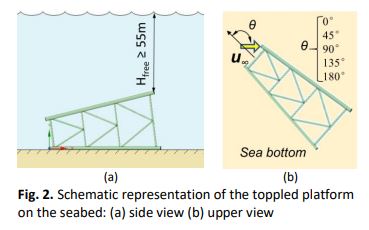A CFD Analysis of Decommissioned Oil Platforms Jackets on the Brazilian Coast
DOI:
https://doi.org/10.37934/cfdl.13.12.6380Keywords:
Decommissioning, artificial reefs, computational fluid dynamics (CFD), oil rigsAbstract
Every facility reaches the last phase in its life cycle, which is decommissioning. Since the last decade, this subject has been gaining importance in Brazil’s offshore oil and gas companies. For jacket type rigs, one of the methods widely applied after idling the production is the conversion of these structures into artificial reefs (ARs). There are several critical aspects for choosing the best strategy for cutting and sinking a platform jacket, ensuring the success of an AR from a biological point of view. One of them is the influence of marine currents and their fluid-structure interaction which, by maximizing local upwelling and back vortex effects, favours the growth of aggregated flora and fauna. This study consists in the application of computational fluid dynamics (CFD) techniques for studying the marine flow around a disassembled and sunk jacket in the seabed for the purpose of converting it into an artificial reef. An FVM (Finite Volume Method) from a commercial software (most recent version of ANSYS FLUENT®) is applied with the upwind scheme. A k-ε turbulence model on steady state is chosen. Field data about Brazilian coastal currents are collected and analysed from the amount of information available on a Brazilian Navy's meteoceanographic program. Next, different combinations of cutting and sinking a jacket are studied, always keeping a minimum 55m free water column. The objective is to verify where the formation of local upwelling regions - that is, where the vertical velocity component reaches values equal or greater than 10% of the magnitude of the free flow velocity - is more significant, without decreasing back eddy formation. It is observed that the dismemberment of the jacket with the positioning of its parts in an increasing height sequence in the direction of the prevailing current is favourable to generate local upwelling while tipping the structure at 90° to the prevailing current results in the most voluminous back eddy region.
Downloads
References
Kaiser, Mark J. "Offshore decommissioning cost estimation in the Gulf of Mexico." Journal of construction engineering and management 132, no. 3 (2006): 249-258. https://doi.org/10.1061/(ASCE)0733-9364(2006)132:3(249)
Zalmon, Ilana R., Ronaldo Novelli, Marcelo P. Gomes, and Vicente V. Faria. "Experimental results of an artificial reef programme on the Brazilian coast north of Rio de Janeiro." ICES Journal of Marine Science 59, no. suppl (2002): S83-S87. https://doi.org/10.1006/jmsc.2002.1273
Baine, Mark. "Artificial reefs: a review of their design, application, management and performance." Ocean & Coastal Management 44, no. 3-4 (2001): 241-259. https://doi.org/10.1016/S0964-5691(01)00048-5
Sammarco, P. W., A. Lirette, Y. F. Tung, G. S. Boland, M. Genazzio, and J. Sinclair. "Coral communities on artificial reefs in the Gulf of Mexico: standing vs. toppled oil platforms." ICES Journal of Marine Science 71, no. 2 (2014): 417-426. https://doi.org/10.1093/icesjms/fst140
Baynes, Tracy W., and Alina M. Szmant. "Effect of current on the sessile benthic community structure of an artificial reef." Bulletin of Marine Science 44, no. 2 (1989): 545-566.
Lindberg, W. J., William Seaman, and Dorothy Zimmerman. Guidelines and management practices for artificial reef siting, use, construction, and anchoring in southeast Florida. Florida Department of Environmental Protection, 2011.
Ito, Yasushi. "Artificial reef function in fishing grounds off Japan." Artificial Reefs in Fisheries Management (2011): 239-264.
Zheng, Yan-xuan, Zhen-lin Liang, Chang-tao Guan, Xie-fa Song, Jiao Li, Yong Cui, Qiang Li, and You Zhou. "Numerical simulation and experimental study of the effects of disposal space on the flow field around the combined three-tube reefs." China Ocean Engineering 29, no. 3 (2015): 445-458. https://doi.org/10.1007/s13344-015-0031-1
Liu, Yan, Chang-Tao Guan, Yun-Peng Zhao, Yong Cui, and Guo-Hai Dong. "Numerical simulation and PIV study of unsteady flow around hollow cube artificial reef with free water surface." Engineering Applications of Computational Fluid Mechanics 6, no. 4 (2012): 527-540. https://doi.org/10.1080/19942060.2012.11015440
Liu, Yan, Yun-peng Zhao, Guo-hai Dong, Chang-tao Guan, Yong Cui, and Tiao-Jian Xu. "A study of the flow field characteristics around star-shaped artificial reefs." Journal of Fluids and Structures 39 (2013): 27-40. https://doi.org/10.1016/j.jfluidstructs.2013.02.018
Rahman, Mohd Asamudin A., Muhammad Nadzrin Nazri, Ahmad Fitriadhy, Mohammad Fadhli Ahmad, Erwan Hafizi Kasiman, Mohd Azlan Musa, Fatin Alias, and Mohd Hairil Mohd. "A Fundamental CFD Investigation of Offshore Structures for Artificial Coral Reef Development." CFD Letters 12, no. 7 (2020): 110-125. https://doi.org/10.37934/cfdl.12.7.110125
Rahman, Mohd Asamudin A., Muhammad Nadzrin Nazri, Fatin Alias, Ahmad Fitriadhy, and Mohd Hairil Mohd. "Computational Fluid Dynamics Analysis of Rigs-to-Reefs (R2R) Jacket Structures." CFD Letters 13, no. 1 (2021): 72-83. https://doi.org/10.37934/cfdl.13.1.7283
Thurman, Harold V. Essentials of Oceanography. 2019.
Kim, Dongha, Jinho Woo, Han-Sam Yoon, and Won-Bae Na. "Wake lengths and structural responses of Korean general artificial reefs." Ocean Engineering 92 (2014): 83-91. https://doi.org/10.1016/j.oceaneng.2014.09.040
Jiang, Zhaoyang, Zhenlin Liang, Yanli Tang, Liuyi Huang, Dingyong Yu, and Mansong Jiang. "Numerical simulation and experimental study of the hydrodynamics of a modeled reef located within a current." Chinese Journal of Oceanology and Limnology 28, no. 2 (2010): 267-273. https://doi.org/10.1007/s00343-010-9228-6
Yaakob, Omar B., Yasser M. Ahmed, M. Rajali Jalal, A. A. Faizul, Koh K. Koh, and Tarmizi J. Zaid. "Hydrodynamic Design of New Type of Artificial Reefs." In Applied Mechanics and Materials, vol. 819, pp. 406-419. Trans Tech Publications Ltd, 2016. https://doi.org/10.4028/www.scientific.net/AMM.819.406
International Maritime Organization (IMO), Resolution A.672(16), Guidelines and Standards for the Removal of Offshore Installations and Structures on the Continental Shelf and in the Exclusive Economic Zone. 1989.
Versteeg, Henk Kaarle, and Weeratunge Malalasekera. An introduction to computational fluid dynamics: the finite volume method. Pearson education, 2007.
Brazilian Navy PNBOIA Data. 2020.
Sorensen, Robert M. Basic Wave Mechanics: for Coastal and Ocean Engineers. John Wiley & Sons, 1993.
Veritas, Det Norske. "Free spanning pipelines." Recommended practice DNV-RPF105 (2006): 1-46.
Ali, Arifah, Adi Maimun, and Yasser Mohamed Ahmed. "Analysis of Resistance and Generated Wave around Semi SWATH Hull at Deep and Shallow Water." Journal of Advanced Research in Fluid Mechanics and Thermal Sciences 58, no. 2 (2019): 247-260.
Pope, Stephen B. Turbulent flows, 2001. https://doi.org/10.1017/CBO9780511840531
Schlichting, Hermann, and Klaus Gersten. Boundary-layer theory. Springer, 2016. https://doi.org/10.1007/978-3-662-52919-5



























